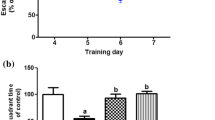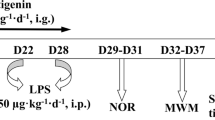Abstract
Cyclic peptides can resist enzymatic hydrolysis to pass through the intestine barrier, which may reduce the risk of mild cognition decline. But evidence is lacking on whether they work by alleviating neuroinflammation. A cylic peptide from Annona squamosa, Cylic(PIYAG), was biologically evaluated in vivo and in vitro. Cylic(PIYAG) enhanced the spatial memory ability of LPS-induced mice. And treatment with Cylic(PIYAG) markedly reduced the iNOS, MCP-1, TNF-α, and gp91phox expression induced by LPS. Cylic(PIYAG, 0.01, 0.05 and 0.2 μM) could significantly reduce the protein expression level of COX-2 and iNOS (P < 0.05) in BV2 cells. The concentration of Cylic(PIYAG) in blood reached a peak of 3.64 ± 1.22 μg/ml after intragastric administration in 1 h. And fluorescence microscope shows that Cylic(PIYAG) mainly locates and may play an anti-inflammatory role in the cytoplasm of microglia. This study demonstrates that the peptidic can prevent microglia activation, decrease the inflammatory reaction, improve the cognition of LPS-induced mice.






Similar content being viewed by others
References
Bilbo SD, Schwarz JM. Early-life programming of later-life brain and behavior: A critical role for the immune system. Frontiers in Behavioral Neuroscience. 3: 670 (2009).
Caron J, Domenger D, Dhulster P, Ravallec R, Cudennec B. Protein digestion-derived peptides and the peripheral regulation of food intake. Frontiers in Endocrinology. 8: 85 (2017).
Chen TL, Lo YC, Hu WT, Wu MC, Chen S Ten, Chang HM. Microencapsulation and modification of synthetic peptides of food proteins reduces the blood pressure of spontaneously hypertensive rats. Journal of Agricultural and Food Chemistry. 51: 1671-1675 (2003).
Chuang PH, Hsieh PW, Yang YL, Hua KF, Chang FR, Shiea J, Wu SH, Wu YC. Cyclopeptides with anti-inflammatory activity from seeds of Annona montana. Journal of Natural Products. 71: 1365-1370 (2008).
Chung YH, Han JH, Lee SB, Lee YH. Inhalation toxicity of bisphenol A and its effect on estrous cycle, spatial learning, and memory in rats upon whole-body exposure. Toxicological Research. 33: 165-171 (2017).
Crackower MA, Sarao R, Oliveira-dos-Santos AJ, Da Costa J, Zhang L. Angiotensin-converting enzyme 2 is an essential regulator of heart function. Nature. 417: 822-828 (2002).
Dang Y, Zhou T, Hao L, Cao J, Sun Y, Pan D. In Vitro and in Vivo Studies on the Angiotensin-Converting Enzyme Inhibitory Activity Peptides Isolated from Broccoli Protein Hydrolysate. Journal of Agricultural and Food Chemistry. 67: 6757-6764 (2019).
Du RH, Sun H Bin, Hu ZL, Lu M, Ding JH, Hu G. Kir6.1/K-ATP channel modulates microglia phenotypes: Implication in Parkinson’s disease. Cell Death and Disease. 9: 404 (2018).
Edvinsson L. Calcitonin gene-related peptide (CGRP) in cerebrovascular disease. The Scientific World Journal. 2: 1484-1490 (2002).
Evans CE, Miners JS, Piva G, Willis CL, Heard DM, Kidd EJ, Good MA, Kehoe PG. ACE2 activation protects against cognitive decline and reduces amyloid pathology in the Tg2576 mouse model of Alzheimer’s disease. Acta Neuropathologica. 139: 485-502 (2020).
Guerreiro RJ, Santana I, Brás JM, Santiago B, Paiva A, Oliveira C. Peripheral inflammatory cytokines as biomarkers in Alzheimer’s disease and mild cognitive impairment. Neurodegenerative Diseases. 4: 406-412 (2007).
Higaki A, Mogi M, Iwanami J, Min LJ, Bai HY, Shan BS, Kan-no H, Ikeda S, Higaki J, Horiuchi M. Recognition of early stage thigmotaxis in morris water maze test with convolutional neural network. PLoS ONE. 13: e0197003 (2018).
Huang Q, Zhao Q, Peng J, Yu Y, Wang C, Zou Y, Su Y, Zhu L, Wang C, Yang Y. Peptide-Polyphenol (KLVFF/EGCG) binary modulators for inhibiting aggregation and neurotoxicity of amyloid-β peptide. ACS Omega. 4: 4233-4242 (2019).
Johnson JD, O’Connor KA, Deak T, Stark M, Watkins LR, Maier SF. Prior stressor exposure sensitizes LPS-induced cytokine production. Brain, Behavior, and Immunity. 16: 461-476 (2002).
Kreutzberg GW. Microglia: A sensor for pathological events in the CNS. Trends in Neurosciences. 19: 312-318 (1996).
Landes MB, Rajaram MVS, Nguyen H, Schlesinger LS. Role for NOD2 in Mycobacterium tuberculosis -induced iNOS expression and NO production in human macrophages. Journal of Leukocyte Biology. 97: 1111-1119 (2015).
Lashley T, Schott JM, Weston P, Murray CE, Wellington H, Keshavan A, Foti SC, Foiani M, Toombs J, Rohrer JD, Heslegrave A, Zetterberg H. Molecular biomarkers of Alzheimer’s disease: progress and prospects. DMM Disease Models and Mechanisms. 11: dmm031781 (2018).
Lee SH, Gomes SM, Ghalayini J, Iliadi KG, Boulianne GL. Angiotensin Converting Enzyme Inhibitors and Angiotensin Receptor Blockers Rescue Memory Defects in Drosophila-Expressing Alzheimer’s Disease-Related Transgenes Independently of the Canonical Renin Angiotensin System. eNeuro. 7: 1-18 (2020).
Liu LR, Liu JC, Bao JS, Bai QQ, Wang GQ. Interaction of Microglia and Astrocytes in the Neurovascular Unit. Frontiers in Immunology. 11: 1024 (2020).
Mann AP, Scodeller P, Hussain S, Braun GB, Mölder T, Toome K, Ambasudhan R, Teesalu T, Lipton SA, Ruoslahti E. Identification of a peptide recognizing cerebrovascular changes in mouse models of Alzheimer’s disease. Nature Communications. 8: 1403 (2017).
Mathys H, Adaikkan C, Gao F, Young JZ, Manet E, Hemberg M, De Jager PL, Ransohoff RM, Regev A, Tsai LH. Temporal Tracking of Microglia Activation in Neurodegeneration at Single-Cell Resolution. Cell Reports. 21: 366-380 (2017).
Meneses G, Rosetti M, Espinosa A, Florentino A, Bautista M, Díaz G, Olvera G, Bárcena B, Fleury A, Adalid-Peralta L, Lamoyi E, Fragoso G, Sciutto E. Recovery from an acute systemic and central LPS-inflammation challenge is affected by mouse sex and genetic background. PLoS ONE. 13: e0201375 (2018).
Morganti-Kossmann MC, Hans VHJ, Lenzlinger PM, Dubs R, Ludwig E, Trentz O, Kossmann T. TGF-β is elevated in the CSF of patients with severe traumatic brain injuries and parallels blood-brain barrier function. Journal of Neurotrauma. 16: 617-628 (1999).
Morita W, Dakin SG, Snelling SJB, Carr AJ. Cytokines in tendon disease: A systematic review. Bone and Joint Research. 6: 656-664 (2017).
Nam KN, Park YM, Jung HJ, Lee JY, Min BD, Park SU, Jung WS, Cho KH, Park JH, Kang I, Hong JW, Lee EH. Anti-inflammatory effects of crocin and crocetin in rat brain microglial cells. European Journal of Pharmacology. 648: 110-116 (2010).
Ni J, Wu Z, Stoka V, Meng J, Hayashi Y, Peters C, Qing H, Turk V, Nakanishi H. Increased expression and altered subcellular distribution of cathepsin B in microglia induce cognitive impairment through oxidative stress and inflammatory response in mice. Aging Cell. 18: e12856 (2019).
Ohrui T, Tomita N, Sato-Nakagawa T, Matsui T, Maruyama M, Niwa K, Arai H, Sasaki H. Effects of brain-penetrating ACE inhibitors on Alzheimer disease progression. Neurology. 63: 1324-1325 (2004).
Park J, Min JS, Kim B, Chae U Bin, Yun JW, Choi MS, Kong IK, Chang KT, Lee DS. Mitochondrial ROS govern the LPS-induced pro-inflammatory response in microglia cells by regulating MAPK and NF-κB pathways. Neuroscience Letters. 584: 191-196 (2015).
Pugh CR, Kumagawa K, Fleshner M, Watkins LR, Maier SF, Rudy JW. Selective effects of peripheral lipopolysaccharide administration on contextual and auditory-cue fear conditioning. Brain, Behavior, and Immunity. 12: 212-229 (1998).
Qiu WWQ, Lai A, Mon T, Mwamburi M, Taylor W, Rosenzweig J, Kowall N, Stern R, Zhu H, Steffens DC. Angiotensin converting enzyme inhibitors and alzheimer disease in the presence of the apolipoprotein e4 allele. American Journal of Geriatric Psychiatry. 22: 177-185 (2014).
Quitterer U, AbdAlla S. Improvements of symptoms of Alzheimer’s disease by inhibition of the angiotensin system. Pharmacological Research. 154: 104230 (2020).
Salim T, Sershen CL, May EE. Investigating the role of TNF-α and IFN-γ activation on the dynamics of iNOS gene expression in lps stimulated macrophages. PLoS ONE. 11: e0153289 (2016).
Sundaram GM, Bramhachari PV. Molecular interplay of pro-inflammatory transcription factors and non-coding RNAs in esophageal squamous cell carcinoma. Tumor Biology. 39: 1-12 (2017).
Tanaka S, Ide M, Shibutani T, Ohtaki H, Numazawa S, Shioda S, Yoshida T. Lipopolysaccharide-induced microglial activation induces learning and memory deficits without neuronal cell death in rats. Journal of Neuroscience Research. 83: 557-566 (2006).
Tannich F, Tlili A, Pintard C, Chniguir A, Eto B, Dang PMC, Souilem O, El-Benna J. Activation of the phagocyte NADPH oxidase/NOX2 and myeloperoxidase in the mouse brain during pilocarpine-induced temporal lobe epilepsy and inhibition by ketamine. Inflammopharmacology. 28: 487-497 (2020).
Tian R, Wu B, Fu C, Guo K. miR-137 prevents inflammatory response, oxidative stress, neuronal injury and cognitive impairment via blockade of Src-mediated MAPK signaling pathway in ischemic stroke. Aging. 12: 10873-10895 (2020).
Tönnies E, Trushina E. Oxidative Stress, Synaptic Dysfunction, and Alzheimer’s Disease. Journal of Alzheimer’s Disease. 57: 1105-1121 (2017).
Torika N, Asraf K, Apte RN, Fleisher-Berkovich S. Candesartan ameliorates brain inflammation associated with Alzheimer’s disease. CNS Neuroscience and Therapeutics. 24: 231-242 (2018).
Tucsek Z, Noa Valcarcel-Ares M, Tarantini S, Yabluchanskiy A, Fülöp G, Gautam T, Orock A, Csiszar A, Deak F, Ungvari Z. Hypertension-induced synapse loss and impairment in synaptic plasticity in the mouse hippocampus mimics the aging phenotype: implications for the pathogenesis of vascular cognitive impairment. GeroScience. 39: 385-406 (2017).
Ushio-Fukai M. Redox signaling in angiogenesis: Role of NADPH oxidase. Cardiovascular Research. 71: 226-235 (2006).
Wakita S, Izumi Y, Matsuo T, Kume T, Takada-Takatori Y, Sawada H, Akaike A. Reconstruction and quantitative evaluation of dopaminergic innervation of striatal neurons in dissociated primary cultures. Journal of Neuroscience Methods. 192: 83-89 (2010).
Wang S, Jing H, Yang H, Liu Z, Guo H, Chai L, Hu L. Tanshinone i selectively suppresses pro-inflammatory genes expression in activated microglia and prevents nigrostriatal dopaminergic neurodegeneration in a mouse model of Parkinson’s disease. Journal of Ethnopharmacology. 164: 247-255 (2015).
Wu P, Wu M, Xu L, Xie H, Wei X. Anti-inflammatory cyclopeptides from exocarps of sugar-apples. Food Chemistry. 152: 23-28 (2014).
Yang YL, Hua KF, Chuang PH, Wu SH, Wu KY, Chang FR, Wu YC. New cyclic peptides from the seeds of Annona squamosa L. and their anti-inflammatory activities. Journal of Agricultural and Food Chemistry. 56: 386-392 (2008)
Acknowledgements
Thanks to the financial support of The Research Fund of Anhui Medical University (A20210020012).
Author information
Authors and Affiliations
Contributions
Con-ceptualization, BL, XW and XS; methodology, BL; software, XW, BL; validation, XW, BL; formal analysis, XW, XS; investigation, BL; resources, BL; data curation, BL; writing-original draft preparation, EC; writing-review and editing, EC; visualization, EC; supervision, EC; project administration, EC; funding acquisition, EC All authors have read and agreed to the published version of the manuscript.
Corresponding authors
Ethics declarations
Conflict of interest
All authors declare that they have no conflicts of interest.
Additional information
Publisher's Note
Springer Nature remains neutral with regard to jurisdictional claims in published maps and institutional affiliations.
Supplementary Information
Below is the link to the electronic supplementary material.
Rights and permissions
Springer Nature or its licensor (e.g. a society or other partner) holds exclusive rights to this article under a publishing agreement with the author(s) or other rightsholder(s); author self-archiving of the accepted manuscript version of this article is solely governed by the terms of such publishing agreement and applicable law.
About this article
Cite this article
Li, B., Shi, X., Chen, E. et al. Improvement effects of cyclic peptides from Annona squamosa on cognitive decline in neuroinflammatory mice. Food Sci Biotechnol 33, 1437–1448 (2024). https://doi.org/10.1007/s10068-023-01441-8
Received:
Revised:
Accepted:
Published:
Issue Date:
DOI: https://doi.org/10.1007/s10068-023-01441-8




